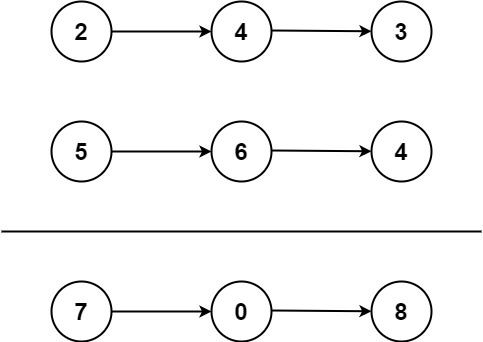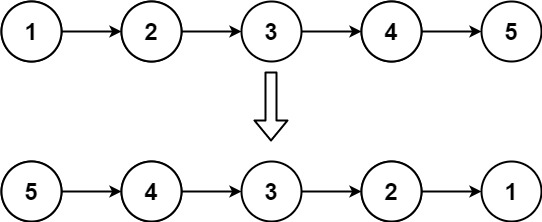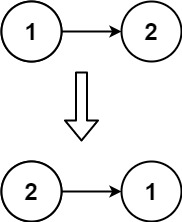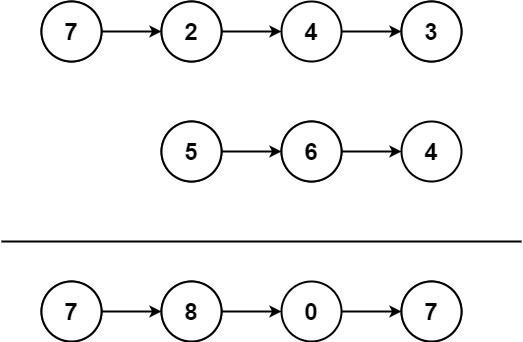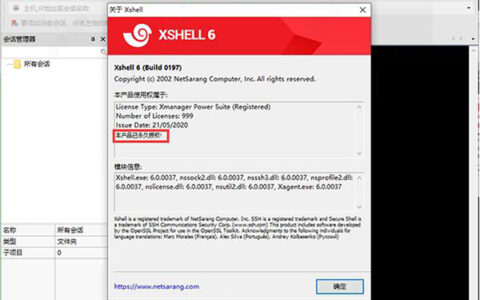目录
一、两数相加
1、题目
2、题目解读
3、代码
二、反转链表
1、题目
2、题目解读
3、代码
三、两数相加 II
1、题目
2、题目解读
3、代码
反转链表再进行计算
借助栈
一、两数相加
1、题目
2. 两数相加 – 力扣(Leetcode)
给你两个 非空 的链表,表示两个非负的整数。它们每位数字都是按照 逆序 的方式存储的,并且每个节点只能存储 一位 数字。
请你将两个数相加,并以相同形式返回一个表示和的链表。
你可以假设除了数字 0 之外,这两个数都不会以 0 开头。
示例 1:
输入:l1 = [2,4,3], l2 = [5,6,4] 输出:[7,0,8] 解释:342 + 465 = 807.
示例 2:
输入:l1 = [0], l2 = [0] 输出:[0]
示例 3:
输入:l1 = [9,9,9,9,9,9,9], l2 = [9,9,9,9] 输出:[8,9,9,9,0,0,0,1]
提示:
- 每个链表中的节点数在范围
[1, 100]内 0 <= Node.val <= 9- 题目数据保证列表表示的数字不含前导零
2、题目解读
因为题目所给链表节点的范围是[1,100],所以我们无法通过将两个链表转换成两个数再进行计算,然后重新转换成链表,数太大了。
题目说:它们每位数字都是按照 逆序 的方式存储的,并且每个节点只能存储 一位 数字。
因此我们就直接进行计算两个链表的值,然后对10进行取模,再进行进位操作。
如下操作:
sum = x + y + carry
carry = sum / 10
sum = sum % 10还需要注意的是如果最后sum不为0还需要进位,也就是再添加一个节点。
运行条件:链表从头遍历到尾,逐位相加 (1)需要保存进位 (2)需要保存结果
结束时:
- 两个链表只要有一个非空就需要往后进行
- 如果链表遍历结束,进位不为0,需要把进位项添加在链表后面
3、代码
java:
/ * Definition for singly-linked list. * public class ListNode { * int val; * ListNode next; * ListNode(int x) { val = x; } * } */ class Solution { public static ListNode addTwoNumbers(ListNode l1, ListNode l2) { ListNode pre = new ListNode(0); ListNode cur = pre; int carry = 0; while(l1 != null || l2 != null) { int x = l1 == null ? 0 : l1.val; int y = l2 == null ? 0 : l2.val; int sum = x + y + carry; carry = sum / 10; sum = sum % 10; cur.next = new ListNode(sum); cur = cur.next; if(l1 != null) l1 = l1.next; if(l2 != null) l2 = l2.next; } if(carry == 1) { cur.next = new ListNode(carry); } return pre.next; } } Python
# Definition for singly-linked list. # class ListNode: # def __init__(self, x): # self.val = x # self.next = None class Solution: def addTwoNumbers(self, l1: ListNode, l2: ListNode) -> ListNode: # 创建一个结点值为 None 的头结点, dummy 和 p 指向头结点, dummy 用来最后返回, p 用来遍历 dummy = p = ListNode(None) s = 0 # 初始化进位 s 为 0 while l1 or l2 or s: # 如果 l1 或 l2 存在, 则取l1的值 + l2的值 + s(s初始为0, 如果下面有进位1, 下次加上) s += (l1.val if l1 else 0) + (l2.val if l2 else 0) p.next = ListNode(s % 10) # p.next 指向新链表, 用来创建一个新的链表 p = p.next # p 向后遍历 s //= 10 # 有进位情况则取模, eg. s = 18, 18 // 10 = 1 l1 = l1.next if l1 else None # 如果l1存在, 则向后遍历, 否则为 None l2 = l2.next if l2 else None # 如果l2存在, 则向后遍历, 否则为 None return dummy.next # 返回 dummy 的下一个节点, 因为 dummy 指向的是空的头结点, 下一个节点才是新建链表的后序节点 二、反转链表
1、题目
206. 反转链表 – 力扣(Leetcode)
给你单链表的头节点 head ,请你反转链表,并返回反转后的链表。
示例 1:
输入:head = [1,2,3,4,5] 输出:[5,4,3,2,1]
示例 2:
输入:head = [1,2] 输出:[2,1]
示例 3:
输入:head = [] 输出:[]
提示:
- 链表中节点的数目范围是
[0, 5000] -5000 <= Node.val <= 5000
2、题目解读
链表简单反转
3、代码
/ * Definition for singly-linked list. * public class ListNode { * int val; * ListNode next; * ListNode() {} * ListNode(int val) { this.val = val; } * ListNode(int val, ListNode next) { this.val = val; this.next = next; } * } */ class Solution { public ListNode reverseList(ListNode head) { ListNode pre=null; ListNode cur=head; while (cur!=null){ ListNode tmp=cur.next; cur.next=pre; pre=cur; cur=tmp; } return pre; } }Python
# Definition for singly-linked list. # class ListNode: # def __init__(self, x): # self.val = x # self.next = None class Solution: def reverseList(self, head: ListNode) -> ListNode: pre = None cur = head while cur: temp = cur.next # 先把原来cur.next位置存起来 cur.next = pre pre = cur cur = temp return pre 三、两数相加 II
1、题目
给你两个 非空 链表来代表两个非负整数。数字最高位位于链表开始位置。它们的每个节点只存储一位数字。将这两数相加会返回一个新的链表。
你可以假设除了数字 0 之外,这两个数字都不会以零开头。
示例1:
输入:l1 = [7,2,4,3], l2 = [5,6,4] 输出:[7,8,0,7]
示例2:
输入:l1 = [2,4,3], l2 = [5,6,4] 输出:[8,0,7]
示例3:
输入:l1 = [0], l2 = [0] 输出:[0]
提示:
- 链表的长度范围为
[1, 100] 0 <= node.val <= 9- 输入数据保证链表代表的数字无前导 0
2、题目解读
这题拆解开来就是上面两题,先进行链表反转,然后继续两数相加。
或者通过栈来完成链表上面数的保存,然后进行计算。
3、代码
反转链表再进行计算
/ * Definition for singly-linked list. * public class ListNode { * int val; * ListNode next; * ListNode() {} * ListNode(int val) { this.val = val; } * ListNode(int val, ListNode next) { this.val = val; this.next = next; } * } */ class Solution { public ListNode addTwoNumbers(ListNode l1, ListNode l2) { ListNode pre1=null; ListNode cur1=l1; while (cur1!=null){ ListNode tmp=cur1.next; cur1.next=pre1; pre1=cur1; cur1=tmp; } ListNode pre2=null; ListNode cur2=l2; while (cur2!=null){ ListNode tmp=cur2.next; cur2.next=pre2; pre2=cur2; cur2=tmp; } l1=pre1; l2=pre2; ListNode pre = new ListNode(0); ListNode cur = pre; int carry = 0; while(l1 != null || l2 != null) { int x = l1 == null ? 0 : l1.val; int y = l2 == null ? 0 : l2.val; int sum = x + y + carry; carry = sum / 10; sum = sum % 10; cur.next = new ListNode(sum); cur = cur.next; if(l1 != null) l1 = l1.next; if(l2 != null) l2 = l2.next; } if(carry == 1) { cur.next = new ListNode(carry); } cur=pre.next; pre=null; while (cur!=null){ ListNode tmp=cur.next; cur.next=pre; pre=cur; cur=tmp; } return pre; } }借助栈
使用栈区进行存储数字,然后再相加计算。
/ * Definition for singly-linked list. * public class ListNode { * int val; * ListNode next; * ListNode() {} * ListNode(int val) { this.val = val; } * ListNode(int val, ListNode next) { this.val = val; this.next = next; } * } */ class Solution { public ListNode addTwoNumbers(ListNode l1, ListNode l2) { Stack<Integer> stack1 = new Stack<>(); Stack<Integer> stack2 = new Stack<>(); while (l1 != null) { stack1.push(l1.val); l1 = l1.next; } while (l2 != null) { stack2.push(l2.val); l2 = l2.next; } int carry = 0; ListNode head = null; while (!stack1.isEmpty() || !stack2.isEmpty() || carry > 0) { int sum = carry; sum += stack1.isEmpty()? 0: stack1.pop(); sum += stack2.isEmpty()? 0: stack2.pop(); ListNode node = new ListNode(sum % 10); node.next = head; head = node; carry = sum / 10; } return head; } }2024最新激活全家桶教程,稳定运行到2099年,请移步至置顶文章:https://sigusoft.com/99576.html
版权声明:本文内容由互联网用户自发贡献,该文观点仅代表作者本人。本站仅提供信息存储空间服务,不拥有所有权,不承担相关法律责任。如发现本站有涉嫌侵权/违法违规的内容, 请联系我们举报,一经查实,本站将立刻删除。 文章由激活谷谷主-小谷整理,转载请注明出处:https://sigusoft.com/163845.html

